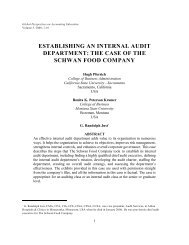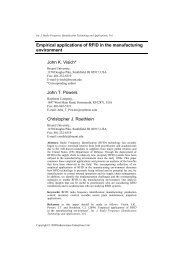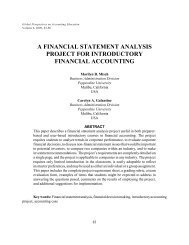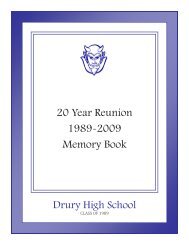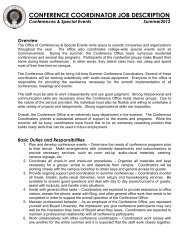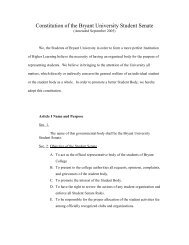Why use multiple-choice questions on accounting - Bryant
Why use multiple-choice questions on accounting - Bryant
Why use multiple-choice questions on accounting - Bryant
You also want an ePaper? Increase the reach of your titles
YUMPU automatically turns print PDFs into web optimized ePapers that Google loves.
<str<strong>on</strong>g>Why</str<strong>on</strong>g> Use Multiple Choice Questi<strong>on</strong>s 41scores is zero). The analyses in Table 7 suggest that <strong>on</strong>ly the data from classes 1, 5 and 8 show nosignificant differences. In all other classes, the t-test statistic was significant at an alpha level of .05.Parametric tests require several assumpti<strong>on</strong>s regarding the normality of the distributi<strong>on</strong> forthe test statistic of interest, and are also sensitive to outliers whose magnitudes can overwhelm thec<strong>on</strong>forming behavior of the remaining data. Accordingly, we also performed a series of Wilcox<strong>on</strong>signed rank tests to overcome this potential problem in our ten sets of class data. Like a matchedpairtest, a Wilcox<strong>on</strong> test also computes the difference in each student’s CR and MC scores, but thenassigns a rank order to each absolute difference. The test statistic is the mean of these ranks (afterreassigning the positive or negative sign to each rank from the original difference). Differences ofzero are removed from further c<strong>on</strong>siderati<strong>on</strong>, explaining why the number of observati<strong>on</strong>s, n, differsfor the same class in some rows of Table 7.Under the null hypothesis that the MC and CR scores come from the same populati<strong>on</strong>, theaverage of these terms should cluster around zero. For each class tested, the results for the Wilcox<strong>on</strong>signed rank test were c<strong>on</strong>sistent with the results of the paired t-test. Again, <strong>on</strong>ly classes 1, 5 and 8were statistically insignificant at an alpha level of .05.Our finding of statistical significance for the majority of our data somewhat c<strong>on</strong>trasts withsome of our regressi<strong>on</strong> results in terms of students performing c<strong>on</strong>sistently between the two testformats. The null hypothesis for both statistical tests reported in Table 7 is that the scores from theMC and CR porti<strong>on</strong>s of our student exams came from the same populati<strong>on</strong>. The statistical outcomesfor seven out of ten tests performed here were that they did not–i.e., that student performance <strong>on</strong> theseparate assessment measures was meaningfully different. In fact, in our sample classes, studentsc<strong>on</strong>sistently performed better <strong>on</strong> the CR porti<strong>on</strong>s of their exams, with mean differences ranging from3.9 percentage points to 19.7 points. We speculate that a student’s ability to earn partial credit <strong>on</strong>the CR porti<strong>on</strong>s of these tests may explain some of this.DISCUSSION AND CAVEATSOur statistical analysis suggests that a positive relati<strong>on</strong>ship exists between the MC and CRscores. This is to say that, while there may be differences in the magnitude of scores, the scores atleast vary in a similar directi<strong>on</strong>. The good news in this finding is the implicati<strong>on</strong> that using MC teststo measure understanding of a given subject area at least points in the right directi<strong>on</strong>–i.e., thoseindividuals who do well <strong>on</strong> MC tests are also likely to do well <strong>on</strong> CR tests, and vice versa. This isheartening news to certificati<strong>on</strong> test developers who seek exactly this relati<strong>on</strong>ship.The results of both our matched-pair tests and our n<strong>on</strong>-parametric tests are somewhat lessencouraging, however–indicating that the MC and CR porti<strong>on</strong>s of each exam were not equivalenttests. The MC porti<strong>on</strong>s of all these student tests, even after adjusting for “gender” and other potentialdifferences in our sample classes, explained about 30 percent of the variati<strong>on</strong> in the scores of the CRporti<strong>on</strong>s of those same tests. Certificati<strong>on</strong> test developers are likely to be disappointed that thisstatistic was not higher. It indicates that the independent variables of our model–particularly studentperformance <strong>on</strong> the MC porti<strong>on</strong>s of the sample examinati<strong>on</strong>s–explained a little less than <strong>on</strong>e thirdof the variability of the dependent (CR) variable. To us, it also suggests that the MC and CR porti<strong>on</strong>sof these tests are testing different types of understanding, or perhaps testing the same understandingat different depths.The reas<strong>on</strong>s for using MC tests instead of CR tests are well documented, and the authorsacknowledge the c<strong>on</strong>venience of employing them <strong>on</strong> certificati<strong>on</strong> examinati<strong>on</strong>s. We would also becomfortable with such formats if we can show that there is a clear and c<strong>on</strong>sistent positive



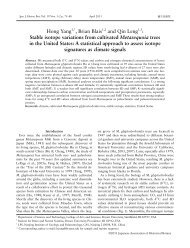
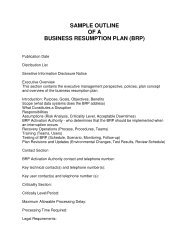
![[1] The Legal Environment of Business (LGLS211) Andrea Boggio ...](https://img.yumpu.com/45269009/1/190x245/1-the-legal-environment-of-business-lgls211-andrea-boggio-.jpg?quality=85)
